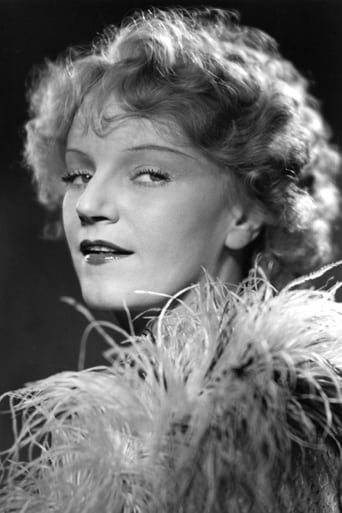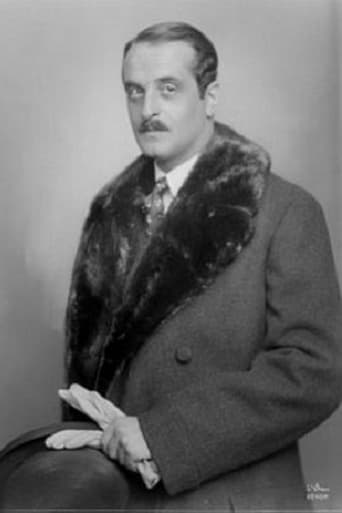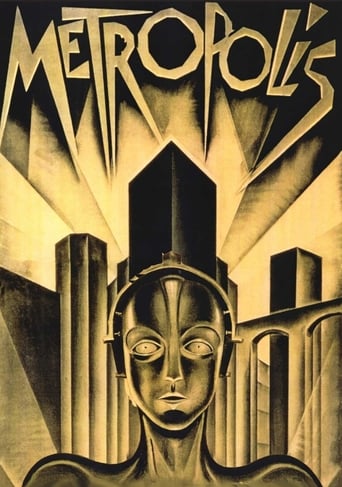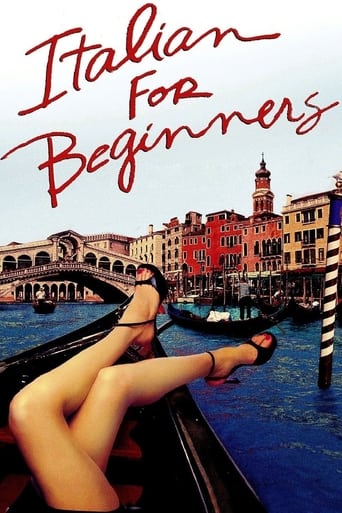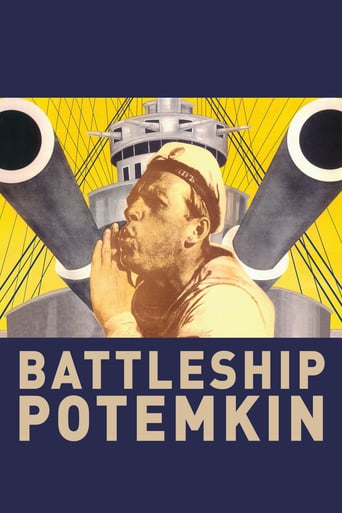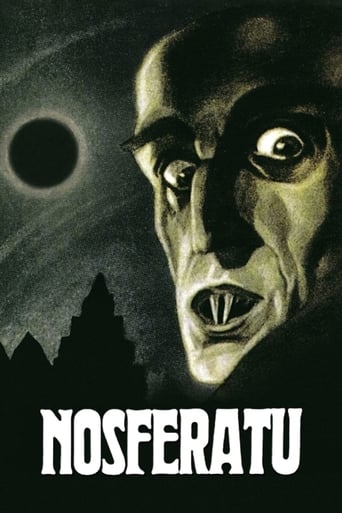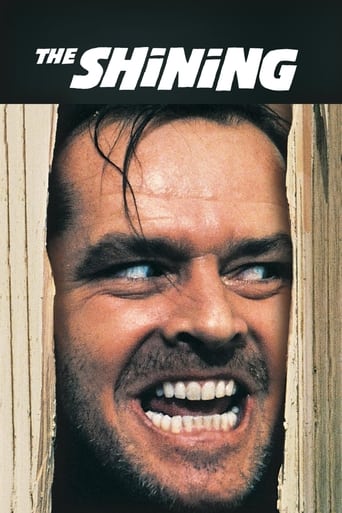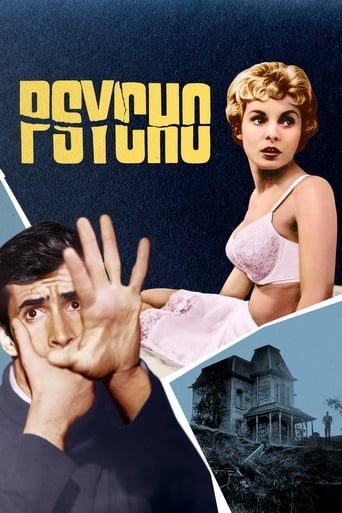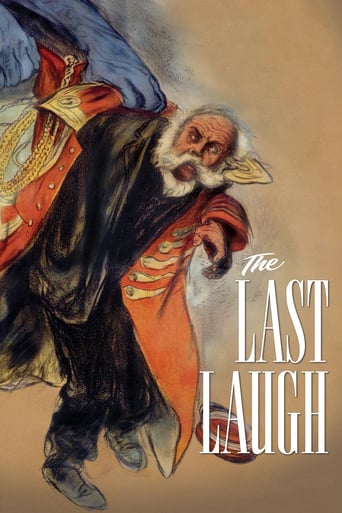
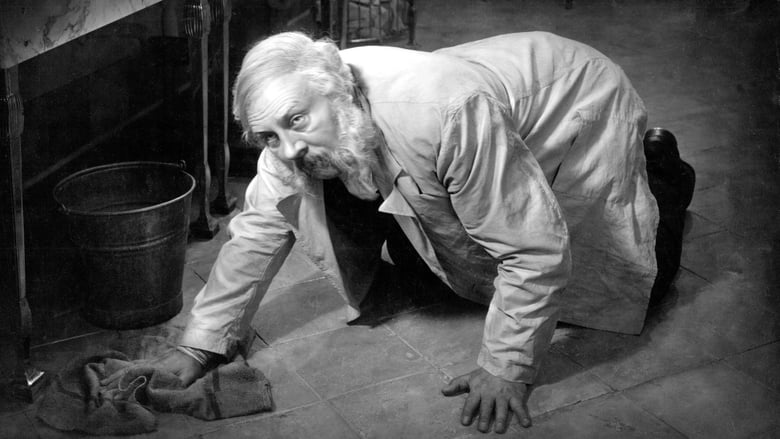
The Last Laugh (1924)
An aging doorman, after being fired from his prestigious job at a luxurious Hotel is forced to face the scorn of his friends, neighbours and society.
Watch Trailer
Cast


Similar titles
Reviews
From director F.W. Murnau (Nosferatu, a Symphony of Horrors, Sunrise), this German silent film was one in the book listing the 1001 Movies You Must See Before You Die, I knew nothing about the plot or title meaning, but I was keen. Basically this film tells the story of a respected, experienced and happy Hotel Doorman (Emil Jannings), he is proud of his position at the famous Atlantic Hotel, with his responsibilities, and dressed in his fancy decorated general-like uniform. One busy rainy night he takes a short break, having carried heavy a suitcase from the wet weather, and he is seen by his Manager (Hans Unterkircher) not performing his duties in that short time, so the next day the Doorman arrives for work and is surprised to see another man in his place, he has been replaced. The Doorman learns that he has been demoted and reassigned to the less strenuous but ultimately degrading position of washroom attendant, but this decision is also because he is considered too old and not the best image to represent the hotel. He tries to hide this demotion and new position from friends and family, but eventually he is discovered, he feels dire shame, his friends think he has been lying about having his former position the whole time, taunting him, while his family shun him due to their shame. The Doorman has no choice but to continue this job, despite feeling great grief, and he uses the bathroom he works in to sleep in, but he finds kindness in the Night Watchman (Georg John) who gives his a coat to cover himself with, but he continues to fall deeper into despair. The only title card that appears at this point says that in real life the story would end with the old man dying in sadness, but the story takes an improbable turn. The Doorman inherits a fortune from a Mexican millionaire, who died in his arms in the bathroom, he later returns to the hotel he worked a happy man to dine with great amounts of food, he is joined by the Night Watchman. The final moments of the film see The Doorman respected once again, now as a rich and valued man, he and the Night Watchman get ready to leave in their horse and carriage, and they are approached by a beggar who asks for money or food, and taking pity on him the men allow him to ride with them in the carriage. Also starring Maly Delschaft as The Doorman's Daughter, Max Hiller as the Daughter's Fiancé, Emilie Kurz as the Fiancé's Aunt, Olaf Storm as as Young Guest and Emmy Wyda as a Thin Neighbor. I suppose the title meaning is to do with the slightly unfathomable and not fully explained happy ending, this was put in on insistence by the producer, probably so audiences would not complain, this could easily be seen as a dream sequence. The film is filled with great black and white imagery, including city backgrounds and hotel interiors, good costumes, Jannings is a wonderful character to sympathise with, and there is no need for any written dialogue because all the visual emotions grab you, a fantastic classic silent drama. Very good!
F.W. Murnau's "The Last Laugh" was the climax of Kammerspiel with its outstanding cinematography, composition and naturalist acting. However, due to the director's remarkable production of the darker variant, the film is often mistaken as a masterpiece of expressionism. As an entirety, the film works as a perfect expression of the mentality and mood that prevailed in Germany between WWI and WWII. The injustice and gloomy atmosphere which finally led to Hitler's rise to power. The film was written by Carl Mayer who was not only the father of Kammerspiel but has also often been considered as the most prominent filmic author in the Weimar Republic. Mayer's scripts are literate film poems, all of which are characterized by profound but yet simple psychological structure. For Mayer, film was, first of all, meant to give form to primitive passions. Moreover, Murnau's unique ability to "think and feel directly in images" gives the film a poetic dimension which drills down into the depths of the human soul.The protagonist of "The Last Laugh" is a respectable doorman who enjoys great appreciation at home and neighborhood. On one day, however, he gets a discount to a lavatory cleaner, and experiences a poignant social humiliation. Unfortunately, he is unable to accept the situation and, therefore, sinks into the dim abyss of self-loathe. The scene in which the protagonist loses his job, represented by the doorman coat, tears the viewer's heart apart with its authentic emotion of despair, submission and loss. He becomes a living dead, so to speak. In fact, all the action built around the coat highlights the ever-worsening existence of the protagonist -- on both social and existential levels.Already in the beginning, Murnau defines the contrasts of the class society, commonly for Kammerspiel, through the visual polarization of architecture: the glowing skyscrapers and the luxury hotel (where the doorman works) meet the gruesome aesthetics of the bleak block where the poor live in misery. The latter is definitely a milieu of deceit and exploitation whereas the former consists of elements -- the elevator and the revolving door -- which enable the hectic lifestyle of the hotel's quests. As a matter of fact, the revolving door becomes a fantastic visual motif of the film. It's the quick doorway of the class society which, at random, let's people inside while leaving others outside. It is made very certain that at any moment any one, who has once got in, can, in future, be thrown out.When it comes to progressive cinematography, "The Last Laugh" was a marvelous achievement. Total mobilization of the camera was presented for the first time on the screen hence the film had a tremendous influence on Hollywood cinema. The camera tracks, pans and heels all being. This not only creates brilliant narrative but also makes it possible for the spectator to observe reality from various vantage points. Specifically, the film was revolutionary because the subjective perspective was transformed to the camera-work. Yet, technique is never self-deliberate for it is constantly related to the film's theme of humiliation. During long takes, the camera shares the experience of social abasement with the protagonist. It goes through the emotions of shame and guilt. The camera might even displace the protagonist if Emil Jannings wasn't so outstanding and superb in his performance. As a genre or avantgardist movement, Kammerspiel produced a great amount of touching and progressive films with minimalist settings even if it never reached the aesthetic level of German Expressionism. Nonetheless, visually speaking, Murnau depicts humiliation, pride and shame in an utterly beautiful fashion. To my mind, Murnau even achieves to give the visual form for Marx's idea of the relation between work and human consciousness. And, in this sense, "The Last Laugh" is a poignant analysis of hierarchy in the class society, and a study on the significance and loss of social status -- its authoritarian and destructive impact on both the community and the psyche of the individual. At its heart, "The Last Laugh" is a portrayal of a man's slow and painful process of abasement, sinking lower and lower.
In the 1920s silent cinema was becoming ever more elaborate and literary. While visual means of storytelling were getting ever more sophisticated, the frequency and length of title cards was also on the up, often adding words where they weren't strictly necessary. This 1924 effort to create a picture entirely without intertitles (bar one at the beginning and one at the end) ought to be a real breath of fresh air, no? Well, director F.W. Murnau was certainly a talented enough fellow to pull off such a thing, in theory at least.Of course, your story can't be too complex – not everything can be explained visually. The Last Man is a simple tale of man enjoys job, man loses job, man mopes about a bit, man inherit fortune and has last laugh. Murnau himself later pointed out that the story is absurd because a washroom attendant (which said man subsequently becomes) would make more money than a doorman. This may be true, but at least the narrative goes to lengths to show the drop in status that the hero suffers. Much is made of the military-style uniform that doormen wear, and the being made redundant is made to look like the degradation of an army officer. The ironic reversal of fortune in the final reel seems both tacked on and dragged out too long. It would be fairly neat if it was just shown to happen, but instead the point is laboured into banality.But even with such a trite storyline, a silent picture without intertitles isn't necessarily easy. So what does Murnau do? He cheats. When Emil Jannings gets the news about his job, he is told in a letter which we see in close-up, which really amounts to the same thing as a title card of someone saying it. This shouldn't have been much of a distraction, but rather than just showing the letter we get words blurring back and forth across the screen, hammering the point home. And throughout the picture Murnau is continually showing off with technique, employing every cheap trick-shot the mechanics of the day allowed, as if that makes up for the lack of text. The bit where the old man dreams of throwing a trunk up and catching it might actually be quite funny, if it wasn't shot through some blurry filter with a wobbly camera. It's a pity because Murnau could be such a wonderful image-maker when he didn't get too absorbed in technical showmanship.Perhaps the worthy talents of lead actor Emil Jannings can help to salvage something of value. Unfortunately this giant of German cinema has one of his hammy turns in The Last Man, and his acting is just as exaggerated as Murnau's formal excess. His caricatured facial expressions and waddling walk are great for comedy, but when he gives that stupid doleful expression when his niece finds him working in the toilets it makes the scene unintentionally funny. Still, it's not all bad. For this performance Jannings has one of those elaborate moustache/sideburn combos which makes his mouth almost invisible, and this encourages him to emote more through his eyes and body language. There's a very touching moment where he sits by the basins drinking his soup.I suppose the fact that Murnau's other pictures are just as wordy as was the norm at that time ought to serve as a warning that he was not necessarily the best man to conduct such an experiment. There were around this time a number of directors who did make good pictures with very sparse intertitles, including Murnau's studio-mates Fritz Lang and G.W. Pabst, or King Vidor in Hollywood. None of these attempted a picture without subtitles, instead recognising them as a necessary burden, using them when needed but keeping them to a minimum. And their late silent pictures are far more satisfying than this corny and overwrought bit of self-indulgence.
From the very first shots of this movie, my friend and I were just in awe of the way Murnau uses the camera to set up his situation. There's an intimacy to it, he brings us close to the characters. Also the way he uses the angles and straight lines of the windows, doors and buildings to frame his shots impresses us immediately with the dehumanizing nature of the city much as it did in his Oscar Winning American film "Sunrise: A Song of Two Humans." As if the impressive direction and photography weren't enough to distinguish this as one of the most impressive films I've seen from the early 20s, the whole affair is anchored by a brilliant performance from Emil Jannings. He plays a man who is retired from his position as a hotel doorman and demoted to the washroom, which leads to a sort of nervous breakdown imaginatively filmed and a fetishistic attachment to the uniform of his former office.This isn't a plot heavy film or a drama heavy film, basically it's a character study. It's remarkable for the fact that there are no dialog title cards, and only 2 or 3 informational title cards relating to various events and anchored to specific informational devices interior to the film (e.g. we see the boss' letter telling him of his demotion). The quality of the acting not only from Jannings but from the entire cast (perhaps with the exception of a broadly played gossip woman) we see very natural performances that you often don't in silent films.Of the 3 films I've seen by Murnau, this film impressed me the most. It doesn't have the melodramatic elements that make "Sunrise" a bit more predictable, and it doesn't have the languid pace that slows "Nosferatu" for me. It reminds me in some ways of the films I've seen from the 30s by Jean Renoir -- there's this fantastic way that the camera follow the actors around on the streets, pulling ahead of them momentarily and then allowing the main actor to zip through the frame while it focuses on incidental details. I'm thinking specifically of the scene where Jannings escapes after stealing back the uniform, but there are several scenes along these lines.Essentially I saw this film as a message of hope, interestingly couched with an explanation from the film-makers that "in reality" it would not have ended happily. It's too easy to see this card, one of as I said only 2 or 3 in the entire film and the only one that's not tied to a specific device, as Murnau's way of eating his cake and having it too. Is there a touch of the ending from this movie, with the two former bums riding off together, that comes to mind when you see Wilder's "Some Like It Hot"? Or has this been filtered by way of Mssrs. Lubitsch and Renoir et al? Either way I would describe the movie overall as purely cinematic, miles and miles beyond normal film-making techniques and taste of the early 20s and even arguably of today.



